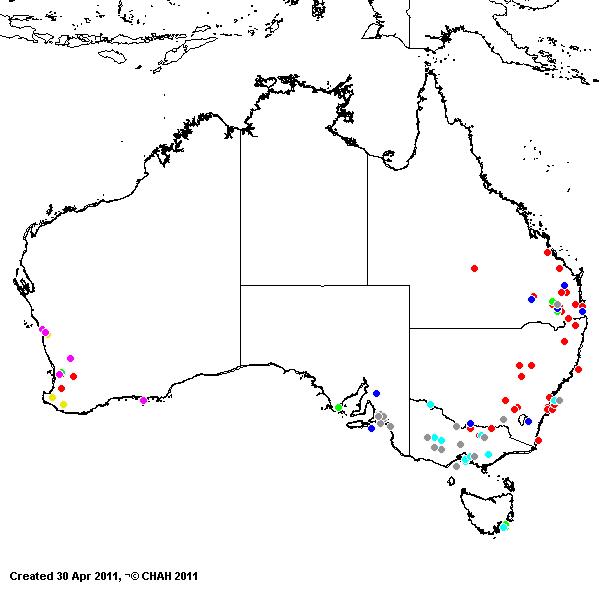Lolium temulentum* Linn. Sp. Pl. 1: 83 (1753).
Classification. (GPWG 2001) : Subfamily Pooideae. Tribe Poeae.
Type of Basionym or Protologue Information: LT: Gramen loliaceum spica longiore (UPS-BURS-Vol. 1, folio 113). LT designated by Loos and Jarvis, Bot. J. Linn. Soc. 108: 408 (1992), who overturn the earlier incorrect lectotypification of Terrell, USDA Bull. 1392: 35 (1968)..
Key references (books and floras): [1878] G.Bentham, Flora Australiensis 7 (667), [1952] C.A.Gardner, Flora of Western Australia 1 Gramineae (193), [2002] D.Sharp & B.K.Simon, AusGrass, Grasses of Australia, [2002] J.Wheeler, N.Marchant & M.Lewington, Flora of the South West (422), [2006] J.Jessop, G.R.M.Dashorst, F.M.James, Grasses of South Australia (138), [2008] S.W.L.Jacobs, R.D.B.Walley & D.J.B.Wheeler, Grasses of New South Wales (298), [2009] A.Wilson (ed.). Flora of Australia, Vol 44A. Poaceae 2 (289 & 290 as var arvense), [1992] J.R.Wheeler et al, Flora of the Kimberley Region (288, Fig.38 as f.temulemtum).
Illustrations: [1952] C.A.Gardner, Flora of Western Australia 1 Gramineae (194, Pl. 57), [2006] J.Jessop, G.R.M.Dashorst, F.M.James, Grasses of South Australia (139, fig. 92, as forma temulentum & fig. 93, as forma. arvense), [2008] S.W.L.Jacobs, R.D.B.Whalley & D.J.B.Wheeler, Grasses of New South Wales, 4th edn (298).
Habit. Annual. Culms erect or decumbent, 30–100 cm tall. Lateral branches simple or branched. Leaf-sheath auricles absent, or present. Ligule an eciliate membrane, 2 mm long. Leaf-blades 6–40 cm long, 3–13 mm wide.
Inflorescence. Inflorescence solid, a spike. Racemes 1, 8.5–30 cm long, bearing 5–22(–30) fertile spikelets on each.
Spikelets. Spikelets sessile. Fertile spikelets many flowered, with at least 2 fertile florets (3–9(-11)), comprising 3–9(–11) fertile floret(s), with diminished florets at the apex, oblong, laterally compressed, 10–27 mm long.
Glumes. Glumes similar to fertile lemma in texture. Upper glume lanceolate or oblong, 10–24 mm long, coriaceous, without keels, 5–9 -nerved. Upper glume surface smooth or asperulous.
Florets. Fertile lemma 6–9.4 mm long, without keel, 5–9 -nerved. Lemma apex muticous or awned, 1 -awned. Median (principal) awn (2–)4.3–17 mm long overall. Grain 5–6 mm long.
Continental Distribution: Europe, Africa, Temperate Asia, Tropical Asia, Australasia, Pacific, North America, South America, and Antarctica.
Australian Distribution: Western Australia, South Australia, Queensland, New South Wales, Victoria, Tasmania.
Western Australia: Irwin, Drummond, Dale, Menzies, Warren, Eyre, Avon. South Australia: Eyre Peninsula, Northern Lofty, Southern Lofty, Kangaroo Island, South-eastern. Queensland: Burnett, Darling Downs, Maranoa, Mitchell, Moreton, Port Curtis. New South Wales: North Coast, Central Coast, South Coast, Northern Tablelands, Southern Tablelands, North-Western Slopes, North-Western Plains, South-Western Plains. Victoria: East Gippsland, Gippsland Plain, Midlands, Riverina, Volcanic Plain. Tasmania: East Coast.
Notes. Previously a weed of cereal crops.
Introduced. All states but N.T. Europe, Mediterranean, eastern Asia and eastern and northern Africa. Terrell (1968) notes the original habitat as unknown. Flowers June-Jan. Fruits Aug.-Jan.
Lemmas awnless L. temulentum f. arvense
Lemmas awned *L. temulentum f. temulentum






